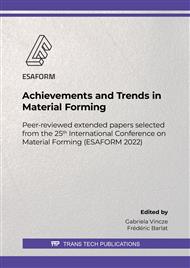[1]
J. Olofsson, I.L. Svensson, P. Lava, D. Debruyne, Characterisation and investigation of local variations in mechanical behaviour in cast aluminium using gradient solidification, Digital Image Correlation and finite element simulation, Materials & Design (1980-2015) 56 (2014) 755-762.
DOI: 10.1016/j.matdes.2013.12.036
Google Scholar
[2]
M. Jolly, L. Katgerman, Modelling of defects in aluminium cast products, Progress in Materials Science (2021).
DOI: 10.1016/j.pmatsci.2021.100824
Google Scholar
[3]
Y. Zhang, J. Zheng, F. Shen, W. Han, S. Münstermann, H. Shou, Q. Liu, Analysis of Local Stress/Strain Fields in an HPDC AM60 Plate Containing Pores with Various Characteristics, Engineering Failure Analysis (2021).
DOI: 10.1016/j.engfailanal.2021.105503
Google Scholar
[4]
Y. Zhang, J. Zheng, Y. Xia, H. Shou, W. Tan, W. Han, Q. Liu, Porosity quantification for ductility prediction in high pressure die casting AM60 alloy using 3D X-ray tomography, Materials Science and Engineering: A 772 (2020) 138781.
DOI: 10.1016/j.msea.2019.138781
Google Scholar
[5]
Y. Zhang, J. Zheng, H. Shou, J. Li, L. Wan, W. Han, Q. Liu, L. Xia, The gradient microstructure and deformation heterogeneity in HPDC AM60 alloy, Materials Science and Engineering: A 792 (2020).
DOI: 10.1016/j.msea.2020.139647
Google Scholar
[6]
J. Kim, X. Gao, T.S. Srivatsan, Modeling of void growth in ductile solids: effects of stress triaxiality and initial porosity, Engineering Fracture Mechanics 71(3) (2004) 379-400.
DOI: 10.1016/s0013-7944(03)00114-0
Google Scholar
[7]
H. Mae, X. Teng, Y. Bai, T. Wierzbicki, Calibration of ductile fracture properties of a cast aluminum alloy, Materials Science and Engineering: A 459(1-2) (2007) 156-166.
DOI: 10.1016/j.msea.2007.01.047
Google Scholar
[8]
K. Nahshon, Z. Xue, A modified Gurson model and its application to punch-out experiments, Engineering Fracture Mechanics 76(8) (2009) 997-1009.
DOI: 10.1016/j.engfracmech.2009.01.003
Google Scholar
[9]
Y. Bai, T. Wierzbicki, A new model of metal plasticity and fracture with pressure and Lode dependence, International Journal of Plasticity 24(6) (2008) 1071-1096.
DOI: 10.1016/j.ijplas.2007.09.004
Google Scholar
[10]
Y. Bai, T. Wierzbicki, Application of extended Mohr–Coulomb criterion to ductile fracture, International Journal of Fracture 161(1) (2009) 1-20.
DOI: 10.1007/s10704-009-9422-8
Google Scholar
[11]
K. Pack, T. Tancogne-Dejean, M.B. Gorji, D. Mohr, Hosford-Coulomb ductile failure model for shell elements: Experimental identification and validation for DP980 steel and aluminum 6016-T4, International Journal of Solids and Structures 151 (2018) 214-232.
DOI: 10.1016/j.ijsolstr.2018.08.006
Google Scholar
[12]
Y. Lou, J.W. Yoon, Anisotropic ductile fracture criterion based on linear transformation, International Journal of Plasticity 93 (2017) 3-25.
DOI: 10.1016/j.ijplas.2017.04.008
Google Scholar
[13]
J. Lian, M. Sharaf, F. Archie, S. Münstermann, A hybrid approach for modelling of plasticity and failure behaviour of advanced high-strength steel sheets, International Journal of Damage Mechanics 22(2) (2012) 188-218.
DOI: 10.1177/1056789512439319
Google Scholar
[14]
M. Baral, J. Ha, Y.P. Korkolis, Plasticity and ductile fracture modeling of an Al–Si–Mg die-cast alloy, International Journal of Fracture 216(1) (2019) 101-121.
DOI: 10.1007/s10704-019-00345-1
Google Scholar
[15]
L. Mu, Z. Jia, Z. Ma, F. Shen, Y. Sun, Y. Zang, A theoretical prediction framework for the construction of a fracture forming limit curve accounting for fracture pattern transition, International Journal of Plasticity 129 (2020).
DOI: 10.1016/j.ijplas.2020.102706
Google Scholar
[16]
F. Shen, H. Wang, Z. Liu, W. Liu, M. Könemann, G. Yuan, G. Wang, S. Münstermann, J. Lian, Local formability of medium-Mn steel, Journal of Materials Processing Technology 299 (2022).
DOI: 10.1016/j.jmatprotec.2021.117368
Google Scholar
[17]
T. Tancogne-Dejean, C.C. Roth, U. Woy, D. Mohr, Probabilistic fracture of Ti–6Al–4V made through additive layer manufacturing, International Journal of Plasticity 78 (2016) 145-172.
DOI: 10.1016/j.ijplas.2015.09.007
Google Scholar
[18]
F. Pütz, F. Shen, M. Könemann, S. Münstermann, The differences of damage initiation and accumulation of DP steels: a numerical and experimental analysis, International Journal of Fracture 226(1) (2020) 1-15.
DOI: 10.1007/s10704-020-00457-z
Google Scholar


